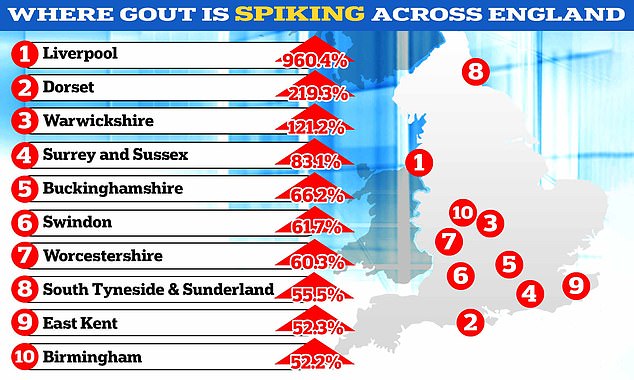Liverpool has been dubbed ‘Britain’s gout capital’ after cases of the ‘Victorian’ disease surged by almost 1,000 per cent, new data reveals.
The painful type of arthritis was historically known as ‘the disease of kings’ because it hit middle-aged men and was believed to be triggered by overindulging on rich foods and alcohol, such a port.
Monarchs including King Henry the VIII and Queen Victoria both suffered from it — however it was relatively uncommon and reserved for the affluent who could afford such diets and live long enough to develop it.
In recent decades, due to increased availability of high fat, sugar and salt foods there has been an increase in cases that has concerned medics.
Data obtained via Freedom of Information laws found Liverpool University Hospitals NHS Foundation Trust recorded 5,864 cases of gout in 2023 — most cases recorded by any NHS trust and a 960 per cent increase on figures recorded in 2019.


Data obtained via Freedom of Information laws found Liverpool University Hospitals NHS Foundation Trust recorded 5,864 cases of gout in 2023




For centuries gout was known as the ‘disease of kings’ with monarchs like King Henry the VIII and Queen Victoria both suffering from the disease
When taken at a citywide level the figure is equivalent to one in 100 Liverpudlians now having gout.
University Hospitals Dorset NHS Foundation Trust was another area of major gout growth with a rise of 219 per cent in cases over the period, followed by South Warwickshire University NHS Foundation Trust which saw a 121 per cent rise in cases.
Gout is an inflammatory reaction to urate crystals that form in and around the joints.
Urate is a byproduct of the body digesting a substance called purine a chemical found in high levels in certain foods.
This includes red meat, offal like liver, and seafood with gravy, beer, sugary drinks also potential sources.
Modern diets have increased the risk of people developing the condition which is also linked to being overweight, as well as a side effect of certain medications, like those designed to tackle high blood pressure.
Navin Khosla a pharmacist at NowPatient, an online pharmacy who carried out the investigation, said the impact of gout on patients should be underestimated.
‘The main symptoms of gout are sudden and severe bouts of pain, which will usually start in the big toe but it can also present itself in the feet, wrists, ankles and other joints of the body,’ he said.
‘Another indication of gout is when the skin over the area of pain turns swollen or red, so if you do experience any of these symptoms, you can take ibuprofen to help ease the pain.’
But gout isn’t the only Victorian-era health problem Liverpool has seen a surge of.
In a seeming paradox, rates of malnutrition are also spiking by 447 per cent in the last five years.
Back in 2019 Liverpool University Hospitals NHS Foundation Trust only recorded 94 cases of malnutrition. But by 2023 this had risen to 514.
Malnutrition isn’t the same as starvation, instead it refers to people not getting the right amount of nutrients.
This can result in people being underweight, but can cause symptoms like fatigue, weakness and frequent illness.
It can be triggered by certain health conditions but is also linked to poverty.
University Hospitals Dorset NHS Foundation Trust also had high malnutrition growth with 180 cases (361 per cent growth) followed by Ashford and St Peter’s Hospitals NHS Foundation Trust in Surrey with 86 cases (218 per cent growth).
Rob Hobson, a registered nutritionist and adviser for Healthspan, said gout is linked to obesity which has been on the rise in the UK years.
And he added that, contrary to popular belief, people can be fat and malnourished.
‘Malnutrition could mean vitamin and mineral deficiencies which is perfectly plausible even if you are obese and the quality of your diet is poor.’
Mr Hobson said poor diets were a particular concern for people existing on a diet ultra-processed-foods (UPFs).
‘UPFs are low in fibre, vitamins and minerals but every energy dense and easy to over consume causing weight gain,’ he said.
He said this is part of trend experts call ‘the hunger-obesity paradox’.
‘Low-income individuals and families often have limited financial resources, leading them to purchase inexpensive, calorie-dense, nutrient-poor foods,’ he said.
‘These foods, such as fast food, processed snacks, and sugary beverages, are high in calories but low in essential nutrients.
‘This represents how people in places like the UK and US can eat enough to be obese but can suffer health problems from their diet being so nutritionally poor.’
Cases of rickets, a bone development problem in children, are also on the rise, data suggests.
Rickets is caused by a lack of vitamin D or calcium, generated by exposure to sunlight and consuming dairy products respectively.
It causes sufferers to have soft weak bones that can cause a variety of pain and deformities.
Children growing up in Victorian Britain’s smog covered streets had poor access to foods rich in vitamin D or calcium, leading to its reputation as a disease of the urban poor.
But now rates are on the rise again in certain parts of the country.
East Kent Hospitals University NHS Foundation Trust had highest growth in cases at 586, a rise of 380 per cent compared to the 122 it recorded in 2019.
Kettering General Hospital NHS Foundation Trust came second with a 138 per cent rise in cases to 1,678.
This was followed by South Tyneside and Sunderland NHS Foundation Trust which recorded a 91 per cent rise in rickets in 2023 to 1,679 cases.
Experts have been warning about a rise in ‘Victorian’ diseases that were reduced to isolated cases in the modern era making a comeback.
This has, in part been, linked to changing a rise in the cost of living leading to some families are cutting fresh foods like fruit and vegetables out of their diet.
Source: Mail Online







